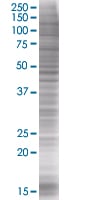Eph receptor A2 overexpression 293T lysate (whole cell) (ab94109)
Overview
-
Product name
Eph receptor A2 overexpression 293T lysate (whole cell)
See all Eph receptor A2 lysates -
General notes
ab94109 is a 293T cell transfected lysate in which Human Eph receptor A2 has been transiently over-expressed using a pCMV-Eph receptor A2 plasmid. The lysate is provided in 1X Sample Buffer. Note: For more details about how the transfected lysate was prepared view preparation notes
-
Tested applications
Suitable for: WBmore details
Properties
-
Mycoplasma free
Yes -
Form
Liquid -
Storage instructions
Shipped on dry ice. Upon delivery aliquot and store at -20ºC. Avoid freeze / thaw cycles. -
Storage buffer
Constituents: 0.01% Bromophenol blue, 2.3% Beta mercaptoethanol, 2% Sodium lauryl sulfate, 0.788% Tris HCl, 10% Glycerol (glycerin, glycerine) -
 Concentration information loading...
Concentration information loading... -
Research areas
-
Background
Function: Receptor for members of the ephrin-A family. Binds to ephrin-A1, -A3, -A4 and -A5. Plays an important role in angiogenesis and tumor neovascularization. The recruitement of VAV2, VAV3 and PI3-kinase p85 subunit by phosphorylated EPHA2 is critical for EFNA1-induced RAC1 GTPase activation and vascular endothelial cell migration and assembly (By similarity). Induces apoptosis in a p53/TP53-independent, caspase-8-dependent manner. Tissue specificity: Expressed in brain and glioma tissue and glioma cell lines (at protein level). Expressed most highly in tissues that contain a high proportion of epithelial cells, e.g., skin, intestine, lung, and ovary. Disease: Genetic variations in EPHA2 are the cause of susceptibility to cataract cortical age-related type 2 (ARCC2) [MIM:613020]. A developmental punctate opacity common in the cortex and present in most lenses. The cataract is white or cerulean, increases in number with age, but rarely affects vision. Defects in EPHA2 are the cause of cataract posterior polar type 1 (CTPP1) [MIM:116600]. A subcapsular opacity, usually disk-shaped, located at the back of the lens. It can have a marked effect on visual acuity. Similarity: Belongs to the protein kinase superfamily. Tyr protein kinase family. Ephrin receptor subfamily. Contains 2 fibronectin type-III domains. Contains 1 protein kinase domain. Contains 1 SAM (sterile alpha motif) domain. PTM: Activated by EFNA1 via tyrosine phosphorylation. Phosphorylated residues Tyr-588 and Tyr-594 are required for binding VAV2 and VAV3 while phosphorylated residues Tyr-735 and Tyr-930 are required for binding PI3-kinase p85 subunit. These phosphorylated residues are critical for recruitment of VAV2 and VAV3 and PI3-kinase p85 subunit which transduce downstream signaling to activate RAC1 GTPase and endothelial cell migration. They also play a critical role in transducing EPHA2 signaling in vascular endothelial cells during tumor angiogenesis.
Images
-
ab94109 at 15μg/lane on an SDS-PAGE gel
-
All lanes : Anti-Eph receptor A2 antibody (ab54968) at 1/500 dilution
Lane 1 :Eph receptor A2 overexpression 293T lysate (whole cell) (ab94109)
Lane 2 : 293T Non Transfected Lysate
Lysates/proteins at 25 µg per lane.
Secondary
All lanes : Goat Anti-mouse IgG (H and L) HRP conjugated at 1/2500 dilution








